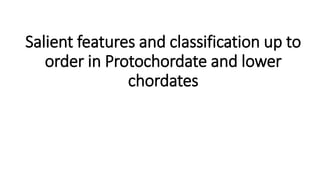
Classification of Phylum: chordates up to class
- 1. Salient features and classification up to order in Protochordate and lower chordates
- 2. General Characters of Phylum Chordata (1) Aquatic, aerial or terrestrial. All free-living with no fully parasitic forms. (2) Body small to large, bilaterally symmetrical and metamerically segmented. (3) A post anal tail usually projects beyond the anus at some stage and may or may not persist in the adult. (4) Exoskeleton often present; well developed in most vertebrates. (5) Body wall triploblastic with 3 germinal layers : ectoderm, mesoderm and endoderm. (6) Coelomate animals having a true coelom. enterocoelic or schizocoelic in origin. (7) A skeletal rod, the notochord, present at some stage in life cycle.
- 5. General Characters of Phylum Chordata 8. A cartilaginous or bony, living and jointed endoskeleton present in the majority of members (vertebrates). 9. Pharyngeal gill slits present at some stage; may or may not be functional. 10. Digestive system complete with digestive glands. 11. Blood vascular system closed. Heart ventral with dorsal and ventral blood vessels. Hepatic portal system well developed. 12. Excretory system comprising proto-or meso-or meta-nephric kidneys. 13. Nerve cord dorsal and tubular. Anterior end usually enlarged to form brain. 14. Sexes separate with rare exceptions.
- 8. Major Subdivisions of Phylum : Chordata
- 9. • Phylum Chordata can be divided into two groups; Acrania (Protochordata) and Craniata (Euchordata) having contrasting characters. • Group A. Acrania (Protochordata) • (Gr. a, absent; kranion, head, or, Gr. protos, first; chorde. cord). All marine, small, primitive or lower • chordates. Lacking a head, a skull or cranium, a vertebral column, jaws and brain. About 2,000 species. • The Acrania is divided into three subphyla: Hemichordata, Urochordata and Cephalochordata, chiefly on the position of notochord.
- 10. Subphylum I. Hemichordata • (Gr. hemi, half; chorde, cord). Body divided into 3 regions : proboscis, collar and trunk. Notochord doubtful, short, confined to proboscis arid non-homologous with that of chordates. • Class 1. Enteropneusta. (Gr. enteron, gut; pneustos, breathed). Body large and worm-like. Gill-slits numerous. Intestine straight. Acorn or tongue worms. Balanoglossus, Saccoglossus. • Class 2. Pterobranchia. (Gr. pteron, feather; branchion, gill). Body small and compact. Gill-slits one pair or none. Intestine U-shaped. Cephalodiscus, Rhabdopleura.
- 11. Subphylum I. Hemichordata • Class 3. Planctosphaeroidea. This class is represented by a few small, rounded, transparent and pelagic larvae, supposed to be specialized tornaria of some unknown hemichordate termed Planctosphaera pelagica. The larval body is covered by extensively branched ciliary bands and its alimentary canal is L-shaped. • Class 4. Graptolita. The fossil graptolites (e.g. Dendrograptus) were abundant in Ordovician and Silurian periods and often placed as an extinct class under Hemichordata. Their tubular chitinous skeleton and colonial habits shoe an affinity with Rhabdopleura,
- 12. Subphylum II. Urochordata or Tunicata • (Gr. oura, a tail; L. chorda, cord). Notochord and nerve cord only in tadpole-like larva. Adult sac-like, often sessile and encased in a protective tunic. Tunicates. • Class 1. Ascidiacea. Sessile tunicates with scattered muscles in tunic. Solitary, colonial or compound. • Gill-clefts numerous. Ascidians or sea squirts. 2 subclass, 3 orders, 12 families, 37 genera and 1,200 • species. Herdmania, Ciona, Molgula.
- 13. Subphylum II. Urochordata or Tunicata • Class 2. Thaliacea. Free-swimming or pelagic tunicates with circular muscles in tunic. Sometimes colonial. • Salps or chain tunicates. • Examples: Salpa, Doliolum, Pyrosoma. • Class 3. I.arvacea or Appendicularia. Tiny, transparent, free-floating. Adults retain many larval features including tail. • Only two -gill-slits. • Examples: Oikopleura.
- 14. Subphylum III. Cephalochordata • (Gr. kephale, head; L. chorda, cord). Notochord and nerve cord present throughout life along entire length of body. • Class Leptocardii. Body fish-like, segmented with distinct myotomes and numerous gill-slits. • Free-swimming and burrowing. Lancelets. • Branchiostomu (=Amphioxus), Asymmetron. About eight species have been recognized under the genus Branchiostoma and six species have been recognized from the genus Asymmetron.
- 15. References • Kotpal, R. L., 2010. Modern text book of zoology: vertebrates. Rastogi Publications. • Verma, P. S., 2013. Chordate zoology. S. Chand Publishing. • Verma, P.S., 2000. A Manual of Practical Zoology: Chordates. S. Chand Publishing. • Lal, S.S., 2009. Practical Zoology Vertebrate. Rastogi Publications. • Tyagi, P., 2010. A textbook of Animal Physiology. Dominant Publishers & Distributors.
